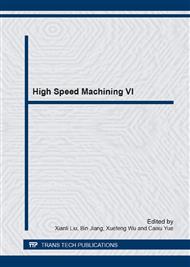p.3
p.9
p.15
p.20
p.26
p.32
p.37
p.42
p.48
The Machinability Comparison of Laser Solid Forming (LSF) and Forging TC4 Alloys
Abstract:
The laser solid forming (LSF) TC4 (Ti6Al4V) alloy is made throughmelting the raw material powder layer by layer with impulse laser beam. The mostrecent advancement of the LSF TC4 alloy exhibits comparable mechanical propertieswith conventional forging TC4 alloy, which enables wider application in the fabrication of structural components in the aerospace industry. However, the accuracy of the LSF process is limited to only about tens of microns due to the laser system,machining is still necessary for the application of LSF TC4 in precision conditions. In this paper, the machinabilities of LSF TC4 and forging TC4 are studied through the turning experiments. In addition, the signature analysis of the cutting force signal is carried out to correlate the anisotropic property of the LSF TC4 with the cutting force dynamic characteristics.
Info:
Periodical:
Pages:
26-31
Citation:
Online since:
July 2014
Authors:
Keywords:
Price:
Сopyright:
© 2014 Trans Tech Publications Ltd. All Rights Reserved
Share:
Citation:


